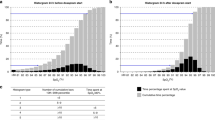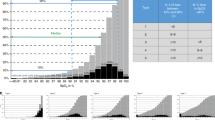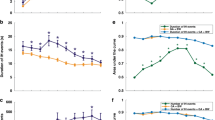Abstract
Objectives
Maintaining preterm infants within a goal oxygen saturation range challenges care providers. Through periodic assessment of saturation trends on infants’ bedside histogram reports, our initiative aimed to (1) increase time spent at goal saturations and (2) reduce death or severe retinopathy of prematurity.
Study design
The initiative integrated histogram monitoring into provider, respiratory, and nursing care. Achieved oxygen saturations, chart audits, and bedside histogram monitoring flowsheets provided process measures with the outcome measure of death or severe retinopathy of prematurity.
Results
In infants <29 weeks’ gestation (n = 518), the rate of death or severe retinopathy of prematurity prior to hospital discharge decreased from 32.1% to 18.0%. Time at goal saturations (90-95%) increased from 48.7% to 57.6%.
Conclusion
In infants born at <29 weeks’ gestation, periodic, multidisciplinary oxygen saturation histogram monitoring improved time at goal saturations and was associated with a reduction in death or severe retinopathy of prematurity.
This is a preview of subscription content, access via your institution
Access options
Subscribe to this journal
Receive 12 print issues and online access
$259.00 per year
only $21.58 per issue
Buy this article
- Purchase on Springer Link
- Instant access to full article PDF
Prices may be subject to local taxes which are calculated during checkout



Similar content being viewed by others
References
Davis JM. Role of oxidant injury in the pathogenesis of neonatal lung disease. Acta Paediatr. 2002;91:23–25.
Haynes RL, Folkerth RD, Keefe RJ, Sung I, Swzeda LI, Rosenberg PA, et al. Nitrosative and oxidative injury to premyelinating oligodendrocytes in periventricular leukomalacia. J Neuropathol Exp Neurol. 2003;62:441–50.
Kinsey VE, Arnold HJ, Kalina RE, Stern L, Stahlman M, Odell G, et al. PaO2 levels and retrolental fibroplasia: a report of the cooperative study. Pediatrics. 1977;60:655–68.
Terry TL. Retrolental fibroplasia in the premature infant: V. Further studies on fibroplastic overgrowth of the persistent tunica vasculosa lentis. Trans Am Ophthalmol Soc. 1944;42:383–96.
Askie LM, Darlow BA, Finer N, Schmidt B, Stenson B, Tarnow-Mordi W, et al. Association between oxygen saturation targeting and death or disability in extremely preterm infants in the neonatal oxygenation prospective meta-analysis collaboration. JAMA. 2018;319:2190–201.
Hagadorn JI, Furey AM, Nghiem TH, Schmid CH, Phelps DL, Pillers DA, et al. Achieved versus intended pulse oximeter saturation in infants born less than 28 weeks’ gestation: the AVIOx study. Pediatrics. 2006;118:1574–82.
York JR, Landers S, Kirby RS, Arbogast PG, Penn JS. Arterial oxygen fluctuation and retinopathy of prematurity in very-low-birth-weight infants. J Perinatol: Off J Calif Perinat Assoc. 2004;24:82–87.
Bizzarro MJ, Li FY, Katz K, Shabanova V, Ehrenkranz RA, Bhandari V. Temporal quantification of oxygen saturation ranges: an effort to reduce hyperoxia in the neonatal intensive care unit. J Perinatol: Off J Calif Perinat Assoc. 2014;34:33–38.
Armbruster J, Schmidt B, Poets CF, Bassler D. Nurses’ compliance with alarm limits for pulse oximetry: qualitative study. J Perinatol: Off J Calif Perinat Assoc. 2010;30:531–4.
van Zanten HA, Pauws SC, Beks EC, Stenson BJ, Lopriore E, Te Pas AB. Improving manual oxygen titration in preterm infants by training and guideline implementation. Eur J Pediatr. 2017;176:99–107.
Lakshminrusimha S, Manja V, Steinhorn RH. Interaction of target oxygen saturation, bronchopulmonary dysplasia, and pulmonary hypertension in small for gestational age preterm neonates. JAMA Pedia. 2016;170:807–8.
Montgomery DC. Introduction to Statistical Quality Control. 4th edn. New York: Wiley; 2000.
Urschitz MS, Horn W, Seyfang A, Hallenberger A, Herberts T, Miksch S, et al. Automatic control of the inspired oxygen fraction in preterm infants: a randomized crossover trial. Am J Respir Crit care Med. 2004;170:1095–1100.
Vagedes J, Poets CF, Dietz K. Averaging time, desaturation level, duration and extent. Arch Dis Child Fetal neonatal Ed. 2013;98:F265–266.
Ahmed SJ, Rich W, Finer NN. The effect of averaging time on oximetry values in the premature infant. Pediatrics. 2010;125:e115–121.
Kaufman DA, Zanelli SA, Gurka MJ, Davis M, Richards CP, Walsh BK. Time outside targeted oxygen saturation range and retinopathy of prematurity. Early Hum Dev. 2014;90(Suppl 2):S35–40.
Network SSGotEKSNNR, Carlo WA, Finer NN, Walsh MC, Rich W, Gantz MG, et al. Target ranges of oxygen saturation in extremely preterm infants. New Engl J Med. 2010;362:1959–69.
Sink DW, Hope SA, Hagadorn JI. Nurse:patient ratio and achievement of oxygen saturation goals in premature infants. Arch Dis Child Fetal neonatal Ed. 2011;96:F93–98.
Ketko AK, Martin CM, Nemshak MA, Niedner M, Vartanian RJ. Balancing the tension between hyperoxia prevention and alarm fatigue in the NICU. Pediatrics. 2015;136:e496–504.
van Zanten HA, Tan RN, Thio M, de Man-van Ginkel JM, van Zwet EW, Lopriore E, et al. The risk for hyperoxaemia after apnoea, bradycardia and hypoxaemia in preterm infants. Arch Dis Child Fetal neonatal Ed. 2014;99:F269–273.
Futier E, Lefrant JY, Guinot PG, Godet T, Lorne E, Cuvillon P, et al. Effect of individualized vs standard blood pressure management strategies on postoperative organ dysfunction among high-risk patients undergoing major surgery: a randomized clinical trial. Jama. 2017;318:1346–57.
Acknowledgements
We would like to acknowledge the care providers across all disciplines that enabled the success of this initiative.
Author information
Authors and Affiliations
Corresponding author
Ethics declarations
Conflict of interest
The authors declare that they have no conflict of interest.
Additional information
Publisher’s note Springer Nature remains neutral with regard to jurisdictional claims in published maps and institutional affiliations.
Rights and permissions
About this article
Cite this article
Gentle, S., El-Ferzli, G., Winter, L. et al. Oxygen saturation histogram monitoring to reduce death or retinopathy of prematurity: a quality improvement initiative. J Perinatol 40, 163–169 (2020). https://doi.org/10.1038/s41372-019-0486-7
Received:
Revised:
Accepted:
Published:
Issue Date:
DOI: https://doi.org/10.1038/s41372-019-0486-7
This article is cited by
-
Oxygen saturation histogram classification system to evaluate response to doxapram treatment in preterm infants
Pediatric Research (2023)
-
Oxygenation in the NICU: there is more to it than meets the eye
Pediatric Research (2023)
-
Advancements in neonatology through quality improvement
Journal of Perinatology (2022)
-
Histogram analysis for bedside respiratory monitoring in not critically ill preterm neonates: a proposal for a new way to look at the monitoring data
European Journal of Pediatrics (2021)



